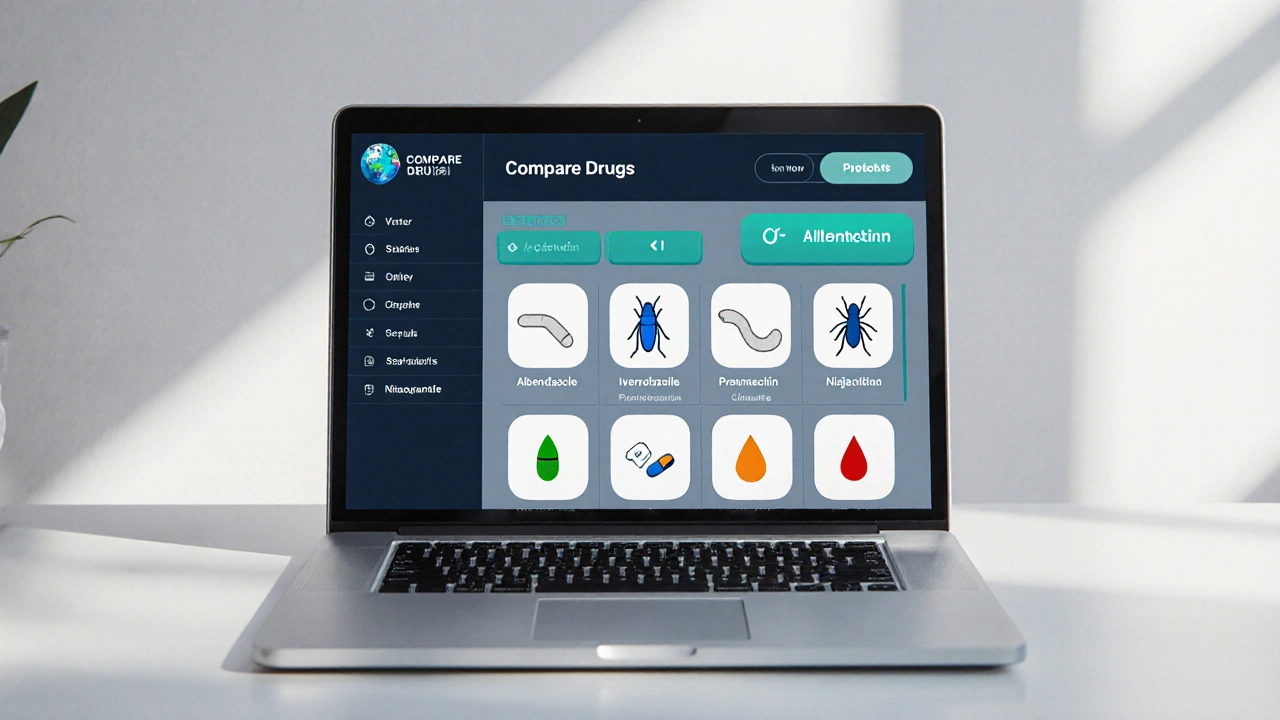Compare Albendazole: A Practical Guide to Anthelmintic Choices
When working with Albendazole, the first step is to know exactly what it is. Albendazole is a broad‑spectrum anthelmintic that treats a range of worm infections. It’s also sold as Albenza, and it works by disrupting the parasite’s microtubule formation, stopping growth and reproduction.
To decide if Albendazole fits your needs, compare it with other common dewormers. Mebendazole is a close cousin that targets similar parasites but often requires a shorter course. Vermox is another name you’ll see on pharmacy shelves. Next, consider Ivermectin, a macrocyclic lactone used for both intestinal and tissue‑dwelling parasites, especially strongyloidiasis. Finally, Praziquantel focuses on trematodes and cestodes, making it the go‑to drug for schistosomiasis.
These four drugs form the core of most helminth‑treatment protocols. The relationship is simple: Albendazole and Mebendazole belong to the benzimidazole class, while Ivermectin and Praziquantel represent different chemical families with distinct mechanisms. Knowing the class helps you predict cross‑resistance and side‑effect patterns.
Key Attributes to Compare
First, look at the spectrum of activity. Albendazole covers hookworms, roundworms, and some tapeworms, whereas Mebendazole leans heavily toward roundworms and pinworms. Ivermectin shines against threadworms and certain skin‑borne parasites, and Praziquantel is unrivaled for flukes and tapeworms that migrate beyond the gut. Second, consider dosing convenience. Albendazole typically uses a 400 mg single dose or a 3‑day 400 mg daily regimen; Mebendazole often needs a 100 mg twice‑daily schedule for three days. Ivermectin is given as a single weight‑based dose, and Praziquantel usually requires a one‑time dose split into two administrations.
Side‑effect profiles also differ. Albendazole can cause mild abdominal discomfort, elevated liver enzymes, and rare blood‑count changes. Mebendazole’s side effects are usually limited to nausea and occasional rash. Ivermectin may trigger dizziness, itching, or, in high doses, neurotoxicity. Praziquantel often leads to headache, nausea, or transient abdominal pain. Understanding these nuances helps you weigh safety against efficacy, especially for pregnant patients or children.
Cost and availability round out the decision. In many regions, Albendazole is cheap and widely stocked in generic form, making it a first‑line choice for mass deworming campaigns. Mebendazole’s price is comparable, but some markets limit its supply. Ivermectin’s price can vary widely due to its use in livestock, while Praziquantel is often more expensive and may require a prescription in specialized pharmacies.
When you line these attributes up, a clear semantic triple emerges: Albendazole offers broad‑spectrum coverage, Mebendazole provides a shorter treatment window, and Ivermectin targets tissue‑dwelling parasites. This logical chain helps you decide which drug matches the infection type, patient profile, and treatment setting.
Clinical guidelines usually recommend Albendazole for common soil‑transmitted helminths, while reserving Praziquantel for schistosomiasis outbreaks. Ivermectin is the drug of choice for onchocerciasis and strongyloidiasis, and Mebendazole stays in the toolbox for quick, low‑cost eradication of pinworm infections. Knowing which organization (WHO, CDC) backs each recommendation gives you confidence in your choice.
Beyond the drugs themselves, supporting factors matter. Proper stool testing confirms the parasite species, ensuring you don’t pick an ineffective drug. Nutrition status, co‑existing illnesses, and concurrent medications can shift the risk‑benefit balance. For example, patients with liver disease need closer monitoring when using Albendazole or Mebendazole.
In practice, many clinicians start with Albendazole for mixed infections because it covers the most common worms with a simple regimen. If treatment fails or the lab identifies a fluke, they switch to Praziquantel. For suspected strongyloidiasis, Ivermectin becomes the first pick. This step‑wise approach mirrors real‑world decision trees seen in primary care.
Below you’ll find a curated set of articles that dig deeper into each comparison point: dosing tables, side‑effect management tips, buying guides for cheap generics, and safety checklists for online pharmacies. Whether you’re a patient looking for the right medication or a health professional building a treatment plan, the collection offers actionable insights you can apply right away.
Ready to explore those detailed write‑ups? Scroll down to see side‑by‑side charts, real‑world buying advice, and expert commentary that will help you pick the safest, most effective anthelmintic for your situation.
Albendazole (Albenza) vs. Other Anti‑Parasitic Drugs: Comparison Guide
A side‑by‑side comparison of Albendazole (Albenza) with five common anti‑parasitic drugs, covering efficacy, dosage, side effects, cost, and when to choose each option.






